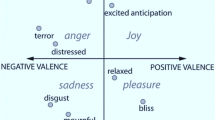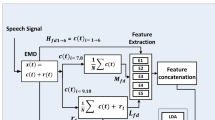Abstract
The most common form of communication is speech. Speech Emotion Recognition is a demanding study area that aims to identify human emotions from speech information (SER). Capturing the emotion from only speech is a difficult challenge. The proper selection of features in relation with both the time and frequency domains together is necessary to produce optimized results. In this paper, four emotional states: Happy, Sad, Anger and Neutral from speech are recognized by using two classifiers. The speech utterances are taken from the Poland Corpus (Database of Polish Emotional Speech). The explored features include Energy, Pitch, Zero-crossing rate and Mel-Frequency Cepstrum Coefficients (MFCC). Performance is compared by employing two different classification algorithms namely, Support vector machine (SVMs) and Linear Discriminant Analysis (LDA). The experimental results reveal that SVM offers15% relative accuracy improvement compared to LDA.
Access this chapter
Tax calculation will be finalised at checkout
Purchases are for personal use only
Similar content being viewed by others
References
Langari, S., Marvi, H., Zahedi, M.: Efficient speech emotion recognition using modified feature extraction. Inform. Med. Unlocked 20, 100424 (2020)
Koolagudi, S.G., Rao, K.S.: Emotion recognition from speech: a review. Int. J. Speech Technol. 15(2), 99–117 (2012)
Yeh, L.-Y., Chi, T.S.: Spectro-temporal modulations for robust speech emotion recognition. In: Eleventh Annual Conference of the International Speech Communication Association (2010)
Indra, J., et al.: A modified tunable–Q wavelet transform approach for tamil speech enhancement. IETE J. Res. 1–14 (2020)
Akçay, M.B., Oğuz, K.: Speech emotion recognition: emotional models, databases, features, preprocessing methods, supporting modalities, and classifiers. Speech Commun. 116, 56–76 (2020)
Kalhor, E., Bakhtiari, B.: Speaker independent feature selection for speech emotion recognition: a multi-task approach. Multimedia Tools Appl. 80(6), 8127–8146 (2020). https://doi.org/10.1007/s11042-020-10119-w
Koduru, A., Valiveti, H.B., Budati, A.K.: Feature extraction algorithms to improve the speech emotion recognition rate. Int. J. Speech Technol. 23(1), 45–55 (2020). https://doi.org/10.1007/s10772-020-09672-4
Liu, Z.-T., et al.: Speech emotion recognition based on feature selection and extreme learning machine decision tree. Neurocomputing 273, 271–280 (2018)
Latif, S., et al.: Transfer learning for improving speech emotion classification accuracy. arXiv preprint arXiv:1801.06353 (2018)
Al Dujaili, M.J., Ebrahimi-Moghadam, A., Fatlawi, A.: Speech emotion recognition based on SVM and KNN classifications fusion. Int. J. Electr. Comput. Eng. 11(2), 1259 (2021)
Özseven, T.: A novel feature selection method for speech emotion recognition. Appl. Acoust. 146, 320–326 (2019)
Kerkeni, L., et al.: Automatic speech emotion recognition using machine learning, in Social media and machine learning, IntechOpen (2019)
Kerkeni, L., et al.: Speech emotion recognition: methods and cases study. In: ICAART (2), 20 (2018)
Chen, L., et al.: Speech emotion recognition: features and classification models. Digital Signal Process. 22(6), 1154–1160 (2012)
Langari, S., Marvi, H., Zahedi, M.: Improving of feature selection in speech emotion recognition based-on hybrid evolutionary algorithms. Int. J. Nonlinear Anal. Appl. 11(1), 81–92 (2020)
Palo, H.K., Mohanty, M.N.: Wavelet based feature combination for recognition of emotions. Ain Shams Eng. J. 9(4), 1799–1806 (2018)
Arias, J.P., Busso, C., Yoma, N.B.: Shape-based modeling of the fundamental frequency contour for emotion detection in speech. Comput. Speech Lang. 28(1), 278–294 (2014)
Swain, M., Routray, A., Kabisatpathy, P.: Databases, features and classifiers for speech emotion recognition: a review. Int. J. Speech Technol. 21(1), 93–120 (2018). https://doi.org/10.1007/s10772-018-9491-z
Rao, K.S., Koolagudi, S.G.: Robust emotion recognition using pitch synchronous and sub-syllabic spectral features. In: Robust emotion recognition using spectral and prosodic features, pp. 17–46. Springer (2013)
Esposito, A., Vích, R.: Cross-modal analysis of speech, gestures, gaze and facial expressions: cost action. In: 2102 International Conference Prague, Czech Republic, October 15–18, 2008 Revised Selected and Invited Papers, vol. 5641 (2009). Springer Science & Business Media
Prabhakaran, G., Indra, J., Kasthuri, N.: Tamil speech enhancement using non-linear spectral subtraction. In: 2014 International Conference on Communication and Signal Processing, pp. 1482–1485. IEEE (2014)
Zehra, W., Javed, A.R., Jalil, Z., Khan, H.U., Gadekallu, T.R.: Cross corpus multi-lingual speech emotion recognition using ensemble learning. Complex Intell. Syst. 7(4), 1845–1854 (2021). https://doi.org/10.1007/s40747-020-00250-4
Koo, H., et al.: Development of speech emotion recognition algorithm using MFCC and prosody. In: 2020 International Conference on Electronics, Information, and Communication (ICEIC), pp. 1–4. IEEE (2020)
Chavhan, Y., Dhore, M., Yesaware, P.: Speech emotion recognition using support vector machine. Int. J. Comput. Appl. 1(20), 6–9 (2010)
Author information
Authors and Affiliations
Corresponding author
Editor information
Editors and Affiliations
Rights and permissions
Copyright information
© 2023 The Author(s), under exclusive license to Springer Nature Switzerland AG
About this paper
Cite this paper
Indra, J., Shankar, R.K., Priya, R.D. (2023). Speech Emotion Recognition Using Support Vector Machine and Linear Discriminant Analysis. In: Abraham, A., Pllana, S., Casalino, G., Ma, K., Bajaj, A. (eds) Intelligent Systems Design and Applications. ISDA 2022. Lecture Notes in Networks and Systems, vol 715. Springer, Cham. https://doi.org/10.1007/978-3-031-35507-3_47
Download citation
DOI: https://doi.org/10.1007/978-3-031-35507-3_47
Published:
Publisher Name: Springer, Cham
Print ISBN: 978-3-031-35506-6
Online ISBN: 978-3-031-35507-3
eBook Packages: Intelligent Technologies and RoboticsIntelligent Technologies and Robotics (R0)




